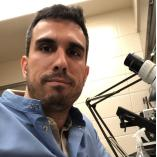Recent Advances in Schwann Cells
A special issue of Biomolecules (ISSN 2218-273X). This special issue belongs to the section "Molecular Medicine".
Deadline for manuscript submissions: closed (28 February 2022) | Viewed by 20124
Special Issue Editors
2. Department of Neurological Surgery, Indiana University School of Medicine, Indianapolis, IN, USA
Interests: Schwann cells; in vitro culture; signaling pathways; proliferation; myelination; reprogramming; cell therapy; human models of glia-neuron interactions; bioassays and products
Interests: Schwann cell plasticity; tumor microenvironment; nerve regeneration; pathologies of the peripheral nervous system
Interests: axon degeneration/regeneration; demyelination; leprosy neuropathy; peripheral neuropathies; Schwann cell-axonal coupling; Wallerian degeneration
Interests: neuron and Schwann cell mechanobiology; mechanosensation; cell and tissue biophysics; 3D in vitro culture system
Special Issue Information
Dear Colleagues,
We are pleased to announce the upcoming Special Issue entitled Recent Advances in Schwann Cells. This Special Issue aims to cover a wide range of topics in which biomolecules are used to investigate or target Schwann cells at the molecular, cellular, and organismal levels.
Schwann cells are ubiquitous glial cells spanning the peripheral nervous system. Though Schwann cells are mostly known for their elaborate myelin sheath and role in facilitating electrical conduction, their functions in the body are multiple and not restricted to ensheathment and myelination. These glial cells are among the largest cells in the mammalian body and are endowed with extraordinary plasticity for functional integration to essentially all tissues. Schwann cells are crucial for the metabolic maintenance of long-projecting axons and play an active role during nerve fiber regeneration and remyelination, which provides a basis for using them in regenerative medicine and nervous system repair strategies. Schwann cells are remarkable for their capacity to associate with and thereby modulate the responses of neuronal cells, the immune system, the vasculature, the surrounding extracellular matrix (ECM), and possibly other glial and nonglial cell types depending on context. The versatile functions of Schwann cells rely on the rich and adaptable nature of their biomolecular repertoire that allows them to establish complex interactions with other cells and the physical environment.
In this Special Issue of Biomolecules, we encourage researchers from all disciplines to share research updates contributing to our increased understanding of molecules of all sorts and their role in Schwann cells' function in health and disease. Selected topics appropriate for this issue may include but are not restricted to those listed below:
- Biochemical and biophysical studies on the biosynthesis, maintenance, and remodeling of peripheral (Schwann) myelin- and ECM-associated molecules, molecular pathways targeting Schwann cells survival, proliferation, differentiation, and reprogramming;
- Biosynthesis, secretion and regulation of Schwann cells-specific adhesion molecules, receptors, soluble growth factors, chemoattractants, antigenic factors, exosomes, and other molecules mediating cell–cell or cell–ECM interactions, and other possible Schwann cells responses;
- Genetic and non-genetic manipulation of Schwann cells, development of in vitro and in vivo models, pharmacological and toxicological studies;
- Schwann cells ‘omics’ (metabolomics, proteomics, transcriptomics, lipidomics);
- Schwann cells-specific genes/molecules/pathways affected by disease, druggable Schwann cells-specific targets, platforms, chemical and genetic screens;
- Biomolecules and biomaterials in Schwann cells engineering; molecular tools to study, modify or derive Schwann cells in vitro or in vivo.
Dr. Paula V. Monje
Dr. Tamara Weiss
Dr. Bruno Siqueira Mietto
Dr. Gonzalo Rosso
Guest Editors
Manuscript Submission Information
Manuscripts should be submitted online at www.mdpi.com by registering and logging in to this website. Once you are registered, click here to go to the submission form. Manuscripts can be submitted until the deadline. All submissions that pass pre-check are peer-reviewed. Accepted papers will be published continuously in the journal (as soon as accepted) and will be listed together on the special issue website. Research articles, review articles as well as short communications are invited. For planned papers, a title and short abstract (about 100 words) can be sent to the Editorial Office for announcement on this website.
Submitted manuscripts should not have been published previously, nor be under consideration for publication elsewhere (except conference proceedings papers). All manuscripts are thoroughly refereed through a single-blind peer-review process. A guide for authors and other relevant information for submission of manuscripts is available on the Instructions for Authors page. Biomolecules is an international peer-reviewed open access monthly journal published by MDPI.
Please visit the Instructions for Authors page before submitting a manuscript. The Article Processing Charge (APC) for publication in this open access journal is 2700 CHF (Swiss Francs). Submitted papers should be well formatted and use good English. Authors may use MDPI's English editing service prior to publication or during author revisions.
Keywords
- glia–neuron or glia–nerve interactions
- myelin
- extracellular matrix
- peripheral nerve
- peripheral neuropathy, cancer, demyelinating disease
- cell/tissue therapies









